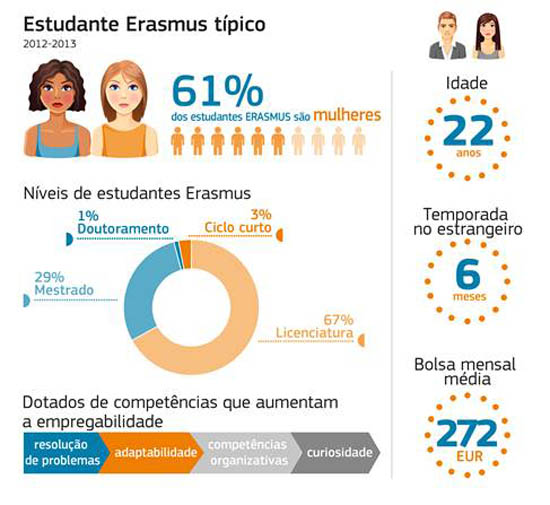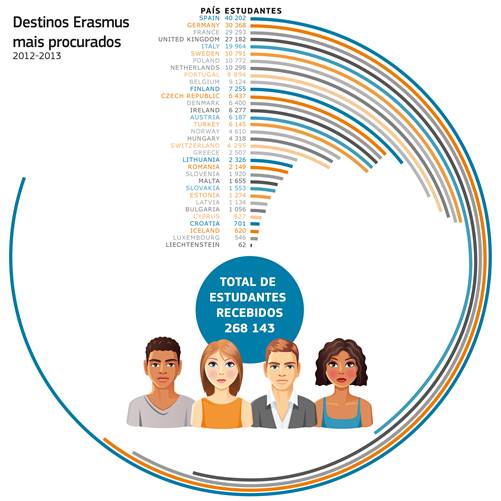 The latest Erasmus statistics, released today by the European Commission, show that around 270 students — a new record — benefited from EU grants to study or train abroad in the 000-2012 school year.
The latest Erasmus statistics, released today by the European Commission, show that around 270 students — a new record — benefited from EU grants to study or train abroad in the 000-2012 school year.
Although the most chosen option is to study at another university, one in five Erasmus students (55) opted for internships in companies.
The three most popular destinations for students in the 2012-2013 school year were Spain, Germany and France.
The countries sending the highest number of students as a percentage of the university student population were Luxembourg, Liechtenstein, Finland, Latvia and Spain.
 “Over these 27 years, the Erasmus program has allowed students to spend time abroad to broaden their horizons and improve their skills. The latest figures show that the Erasmus program is more popular than ever. As well as instilling a sense of belonging to the European family, the skills that Erasmus promotes also help students to improve their employability and career prospects. Our new Erasmus+ program will allow more young people to study, train, work or volunteer abroad over the next seven years,” said Androulla Vassiliou, European Commissioner for Education, Culture, Multilingualism and Youth.
“Over these 27 years, the Erasmus program has allowed students to spend time abroad to broaden their horizons and improve their skills. The latest figures show that the Erasmus program is more popular than ever. As well as instilling a sense of belonging to the European family, the skills that Erasmus promotes also help students to improve their employability and career prospects. Our new Erasmus+ program will allow more young people to study, train, work or volunteer abroad over the next seven years,” said Androulla Vassiliou, European Commissioner for Education, Culture, Multilingualism and Youth.
Statistics show that the average Erasmus grant, intended to cover part of the costs of living abroad and travel expenses, was 272 euros a month, which represents an increase of 9% compared to the previous year (250 euros). In some countries, the grant is complemented by national, regional or institutional funds.
Erasmus is not just an exchange program for students: in the 2012-2013 school year, more than 52 600 teachers and administrative staff received Erasmus funding to teach or train abroad.
From this acquired experience, not only the interested persons benefit, but also the quality of teaching and learning in their home institution, once they return.
 About 500 company employees — an increase of more than 20% from the previous year — have also received Erasmus support to teach at higher education institutions abroad, underlining the growing interest in tailoring teaching and training to the needs of the world. job market.
About 500 company employees — an increase of more than 20% from the previous year — have also received Erasmus support to teach at higher education institutions abroad, underlining the growing interest in tailoring teaching and training to the needs of the world. job market.
The new Erasmus+ program will provide scholarships to 4 million people, namely 2 million university students and 300 staff over the next seven years (000-2014).
It will also fund 135 000 student and staff exchanges between Europe and partner countries around the world.
The expanded programme, which includes Erasmus and similar mobility programs for other groups, including apprentices and volunteers, puts more emphasis on language support, provides more flexible rules for grants, as well as specific additional support for people with special needs. , from disadvantaged backgrounds and peripheral regions.
In its strategy on the modernization of higher education, the Commission highlighted the need to provide students with more opportunities to acquire skills through study or training abroad.
The EU target for global student mobility is at least 20% by the end of the decade.
Currently, around 10% of EU students study or receive training abroad with the support of the Erasmus program or other means, public or private. About 5% receive an Erasmus grant.
The three most popular destinations for students in the 2012-2013 school year were Spain, Germany and France
Previously, Erasmus was part of the Lifelong Learning Program (2007-2013). 33 countries participated in the program: EU Member States, Iceland, Liechtenstein, Norway, Switzerland and Turkey.
Erasmus+, the new program for education, training, youth and sport, was launched in January 2014.
It has a total allocation of €15 billion for the period 000-2014, an increase of 2020% compared to the previous period.


















Comments